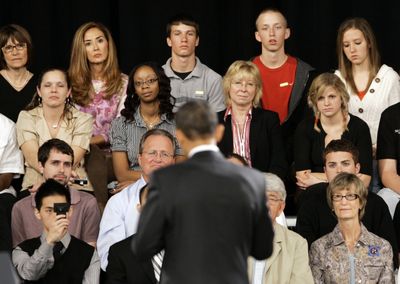Economic boost to aid construction, data entry

SAN FRANCISCO – From upgrading the electricity grid to rebuilding bridges to computerizing medical records, there are plenty of ways the economic-stimulus bill aims to prop up the economy and create millions of jobs.
But what kinds of jobs – and who will qualify for them? Those are questions that 11.6 million unemployed Americans may well be asking.
For construction workers, the stimulus plan may be the best news in years. After losing 900,000 jobs since September 2006, as many as 670,000 construction workers could be back on the job by the end of 2010, according to some estimates – if the stimulus bill works as planned.
That job growth would come from projects to rebuild roads and bridges, plus make schools, homes and government buildings more energy-efficient, among other initiatives.
Meanwhile, computer programmers, information-technology experts and data-entry workers should benefit from the goal to computerize the nation’s medical records. “The idea is to have the entire U.S. hospital and medical system able to share medical records,” says Ross Eisenbrey, vice president of the Economic Policy Institute, a liberal think tank in Washington.
Still, the stimulus plan includes saving jobs, not just creating them. Other than construction, most new jobs may not emerge until next year, Eisenbrey said.
Overall, the stimulus plan would create or save about 3.6 million jobs by the end of 2010, according to projections last month by Christina Romer and Jared Bernstein, economists in the Obama administration, based on early versions of the stimulus plan. They say a stimulus bill would mean an unemployment rate of 7 percent in 2010, versus 8.8 percent otherwise.
Many uncertainties remain. The estimates are based on an early draft version of the bill. The Senate passed its version of the bill Tuesday; the House has already passed a bill and there are some big differences between the two that will have to be worked out. Also, assessing job creation is an inexact science.
Mark Zandi, chief economist with Moody’s Economy.com, said last month that about 3 million jobs would be created or saved by the end of 2010. Sectors beyond construction should see a pick up in hiring thanks to billions of additional dollars pushed through the economy – Zandi forecast an added 386,000 retail and 346,000 leisure and hospitality jobs – but also directly through planned projects.
For instance, the plan’s focus on alternative energy would help wind farms, which need manufacturers to make turbine components, operations and maintenance people to run farms, and financial-services workers to structure financing for these projects, said Britt Theismann, membership director of the American Wind Energy Association, a trade group.
A plan to improve the nation’s electricity infrastructure and craft a “smart grid,” eventually giving consumers more control over their electricity use, might create jobs for electrical, communications and computer engineers, said Gordon Day, president of the IEEE-USA, a professional association for engineers.
Health care and government workers should benefit from a big influx of federal funds into the Medicaid program and other aid to states, plus an expected expansion of health care benefits for unemployed people, said Paul McIntosh, executive director of the California State Association of Counties, in Sacramento.